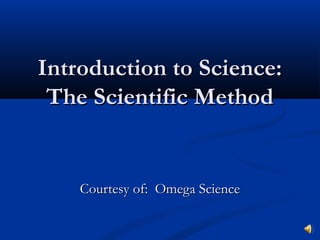
Scientific method powerpoint.php
- 1. Introduction to Science: The Scientific Method Courtesy of: Omega Science
- 2. What is Science? The knowledge obtained by observing natural events and conditions in order to discover facts and formulate laws or principles that can be verified or tested.
- 3. What is Physical Science? The scientific study of non-living matter. Chemistry The study of all forms of matter, including how matter interacts with other matter. Physics The study of energy and how it affects matter.
- 4. What is the Scientific Method? Step-by-step way in which scientists answer questions. 1. Ask a question. 2. Research the topic. 3. Form a hypothesis. 4. Test the Hypothesis. 5. Gather Data. 6. Analyze Results. 7. Draw Conclusions. 8. Communicate Results.
- 5. State the Problem/Questions The problem identifies what you want to find out. Develop a clear statement defining the problem Make sure your problem is narrowed/specific enough State the problem in the form of a question: How does __________ affect _______? What is the effect of _______ on ________?
- 6. Research Write down all information you already know Do research in books on the topic you are investigating Ask experts on the subject you are researching If you find an answer to your problem/question you do not need to move on
- 7. What is a hypothesis? An explanation that is based on prior scientific research or observations and that can be tested. “Educated Guess” ( your high school teacher may not like this definition) “If… then… because” Statement
- 8. How do you test a hypothesis? Develop a test to support or not support your hypothesis. (This is your experiment). Must be run multiple times Must have only 1 independent variable (the factor being tested Must include 2 setups Experimental setup Control setup
- 9. How do you test a hypothesis? Use a Controlled Experiment An experiment that tests only one factor at a time by using a comparison of a control group and an experimental group. Control Group The group that the scientist changes nothing in. The Control group is used for comparison. Experimental Group The group that the scientist has changed something. It is the variable in the experiment where you want to see how this condition affects something.
- 10. What is a variable? A variable is something that can change, either naturally or on purpose. *** In an experiment it is a factor that is different from one group to another. Independent variable The factor that the scientist has changed in order to test the hypothesis (on purpose). It is the cause Dependent Variable The result of what the scientist changed. It is the effect of what happened in the experiment.
- 11. What are constants? They are what the scientist kept the same in both the control group and the experimental group.
- 12. How can you gather data? Make Observations. Any use of the senses to gather information. Qualitative Observations Anything that you see, smell, touch, taste, or hear. Ex. Blue, bitter, fizzing sound. Quantitative Observations Any observation that can be measured. Must include a number. Ex. 5 centimeters long
- 13. How can you analyze results to determine patterns? Record Data Write observations and measurements Be consistent when you are checking your experiments and recording the results Create tables or charts (Data Tables and Pie Charts) Create graphs from collected Data (Line Graphs, Bar Graphs) Complete all necessary mathematical calculations
- 14. How can you draw conclusions? Answer the following questions in paragraph form (Always explain in detail using scientific vocabulary.): Do your results/data support your hypothesis? Why or why not? What are ways you can improve your data? What would you do differently if you were to repeat the experiment?
- 15. What is in a conclusion? You restate the purpose of your experiment You indicate what the results were. Use numbers!!!!! Example: “On average after 3 trials, …….” You explain why those results were given. Here you think about what you found out in your research. You consider any improvements to your procedure. This is error analysis. You ask a new question – what do you want to
- 16. How would you communicate results? Share data and information with others, such as scientists. Publish your findings in a book, magazine, journal, the internet.
- 17. Let’s try! Six bean plants are to be tested to see what happens if light is taken away. The all have the same type of container, the same amount of soil, and they will receive the same amount of water. Three will be placed in a sunlit window and 3 will be placed in a dark closet for 2 weeks. 1. What is the question? 2. Research. 3. Form a Hypothesis. 4. Test your hypothesis.
- 18. Let’s try continued… 4a. What is the control group? 4b. What is the experimental group? 4c. What is the independent variable? 4d. What is the dependent variable? 4e. What are the constants? 5. Gather data. 5a. What are some Qualitative observations you can make? 5b. What are some quantitative observations you can make?
- 19. Let’s try continued…again. 6. Analyze results. 6a. How can you show your results? 7. Draw Conclusions? 7a. How do you write a conclusion paragraph?
- 20. What are scientific models? Model A representation of an object or system. Physical Models Mathematical Models Conceptual Models
- 21. What is the difference between a scientific theory and a scientific law? Theory Law An explanation that ties A summary of many together many hypotheses experimental results and and observations. observations. Supported by repeated Tells how things work trials. Only tells what happens, May help with further it does not explain why. predictions. Tells why it happens.